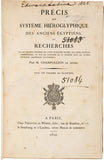Précis du système hiéroglyphique des anciens Egyptiens, ou recherches sur les éléments premiers de cette écriture sacrée, sur leurs diverses combinaisons, et sur les rapports de ce système avec les autres méthodes graphiques égyptiennes.
Author: Jean-François Champollion (1790-1832)
Year: 1824
Publisher: Chez Treuttel et Würtz
Place: Paris
Description:
Two parts in one volume. xvi+408+[2 table] pages with 16 full-page lithograph plates (four folding); [2]+45 pages with 21 numbered full-page plates and 11 full-page plates lettered A-K. Octavo (8 3/4" x 5 3/4") bound in half leather with five raised spine bands and gilt lettering to spine over marbled boards. Head edge in gilt. First edition.
Jean-François Champollion, French historian and linguist who founded scientific Egyptology and played a major role in the decipherment of Egyptian hieroglyphs.
At age 16 Champollion had already mastered six ancient Oriental languages, in addition to Latin and Greek, and delivered a paper before the academy of Grenoble, France, in which he asserted, incorrectly, that Coptic was the ancient language of Egypt. At 19, following studies in Paris, he became professor of history at the lycée of Grenoble (1809–16).
Deciphering hieroglyphs became his constant preoccupation. Following the modest success of the English physicist Thomas Young in attempting to decipher the Rosetta Stone, which was engraved with a Greek text along with hieroglyphic and demotic versions, Champollion at last began to piece together the puzzle of the hieroglyphs. In 1821–22 he started publishing papers on the hieroglyphic and hieratic elements of the Rosetta Stone, and he went on to establish an entire list of hieroglyphic signs and their Greek equivalents. He was first to recognize that some of the signs were alphabetic, some syllabic, and some determinative—i.e., standing for a whole idea or object previously expressed. Though many doors still awaited opening, the key to understanding ancient Egypt had at last been found. His brilliant discoveries met with opposition, however, often bitter and personal, from some other scholars.
Condition:
Binding with moderate scuffing and shelf-wear to edges; spine ends with some loss and damage; joints tender with front joint separated from text block; armorial bookplate mounted to front pastedown; contemporary owner's name and library catalog numbers on the title page; scattered light to moderate foxing throughout; faded ink stamp on title and verso of most plates (not bleeding through); else Good.

















